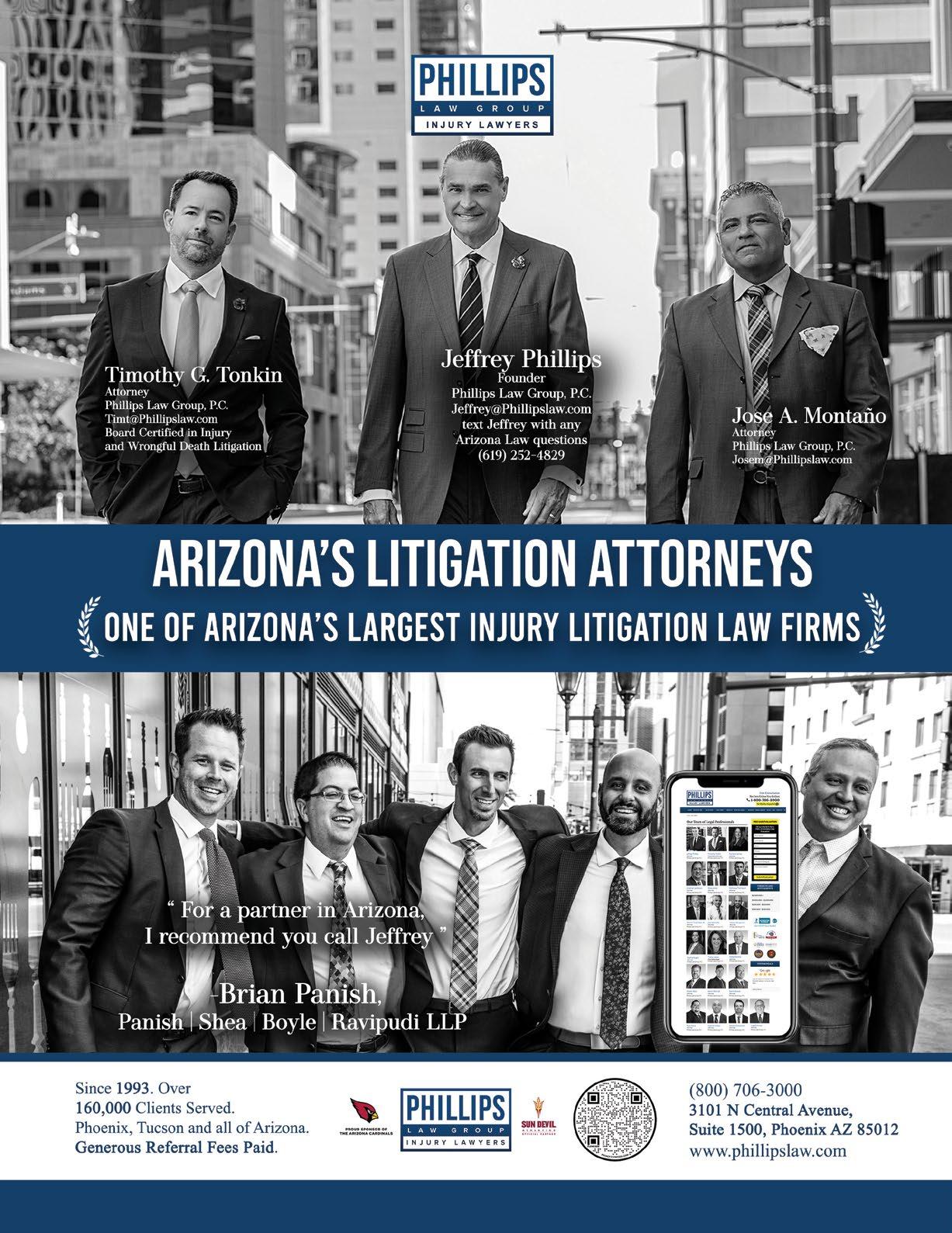
12 minute read
Nineteen Steps to Building a Regional or National Law Practice
Many lawyers are expanding their practices beyond state boundaries, building a regional or national practice. In some cases, they provide narrowly focused services; in others, they offer broad-based skills with the hopes of attracting a handful of the best cases in the country. If your practice area is suited to going beyond your state boundaries, here are four reasons to consider a regional or national practice:
Reason #1: You have more opportunities to attract
the types of cases you want. When you draw clients from 50 states, you have a much greater selection than when you limit your field to your home state. If every state has three really good cases, you can compete for the three in your own state—or you can compete for your share of 150 from across the U.S.
Reason #2: You have many more opportunities for
media publicity. Gaining publicity outside your state is often easier than getting attention in your own state. This is because nearly every business wants to be featured in your local newspapers. But when you pursue articles in regional and national publications, you often find yourself competing with fewer businesses and fewer lawyers.
Most businesses and lawyers get customers from within a few-mile radius, so they don’t need attention beyond their local boundaries. Plus, businesses often assume that gaining national publicity would be much harder than gaining local attention. But, in fact, when you go beyond your state’s boundaries, you have access to hundreds of additional publications at the state, regional and national levels, all of which could be suitable targets for your publicity effort.
Reason #3: The “mystery of distance” results in your being perceived as the authority in your field because
you’re from out of town. You have probably heard of this marketing principle, but you may not have used it as part of your marketing strategy. The mystery of distance says: The farther you go to get a product or service, the better and more valuable it is. Here’s an example:
You can buy a pair of binoculars at your local sporting goods store. Or you can buy them online from a company in Switzerland. Which pair is better? Obviously, the binoculars from Switzerland.
There’s no logical reason to believe that something that comes from far away is better than something that comes from down the street. Still, subconsciously, we think it is.
Reason #4: You can live wherever you want. Many lawyers don’t need to meet their clients face to face. If you can service clients by phone, fax, mail and email, then you don’t need to work with them in person. And if you go to trial in their state—or if you need to meet with them—you can always travel. Technology has changed how we market and deliver services.
by Trey Ryder
Here Are 19 Steps To Building a Respected Regional or National Practice
STEP 1 Identify the niche you want to fill and the services you want to market. When clients hear your name, you want them to associate you with a specific type of legal services. For example, John Wilbanks is a personal injury attorney. Karen Ambrose is a tax lawyer. Mark O’Connor is a corporate lawyer. Consider whether any lawyer in your market area immediately springs to mind when you mention your area of law. If so, that lawyer owns a very strong position. If no lawyer comes to mind, an effective marketing program will help you build the perception that you are the leader in that practice area.
STEP 2 Identify the type of clients you want to attract. You must know where to aim if you expect to hit your target. List the types of people or companies you want to attract that are ready, willing and able to hire your services. Identify your prospective clients by who they are and what they have. For individuals, consider things such as gender, age, marital and family status, education, occupation, income and home ownership. For companies, consider things such as industry, gross sales, number of employees, level of risk or whatever makes a client attractive to you.
STEP 3 Identify how you and your services differ from those of your competitors. Positive differences are your competitive advantages. Negative differences are your competitive disadvantages. Identify both so you’ll know your strengths and weaknesses. Evaluate your qualifications, background and experience. Evaluate how you serve clients. Evaluate the environment in which you serve clients. Look at your strengths and weaknesses from your prospects’ point of view because prospects evaluate you based on what is important to them. Every time you talk with prospects, make sure you emphasize your competitive advantages, so prospects appreciate how you differ from other lawyers.
STEP 4 Identify ways you can add value to your services so prospects eagerly choose you over all other lawyers. What can you add to your services to make them more attractive than they are now—and more attractive than services offered by competitors? If you were in your prospect’s shoes, what could your lawyer provide that would cause you to choose him or her over every other attorney? Review how you currently provide legal services. Then ask yourself how you could provide services more efficiently, more effectively, more completely, or faster—with your client benefiting from less risk and more value. Then, in addition to what you listed in step 3, the ways you add value to your services now become more competitive advantages.
STEP 5 Compile and keep on computer a comprehensive mailing list. Your most important business asset is your mailing list. It’s your own personal area of influence. It should include your current clients, past clients, prospective clients, referral sources and prospective referral sources. Whether your list contains 20 names—or 2,000 names—these people are the core around which you build a prosperous firm. As you attract an ongoing flow of new inquiries, keep all of the names and addresses on your mailing list.
The critical element in your marketing program is your ability to add new names of prospective clients to your mailing list. You want to attract names at whatever rate will bring you the number of new clients you want. How long you leave names on your mailing list will depend on how long your prospects need to make their decision and at what point, if any, the list becomes unmanageable.
STEP 6 Make sure prospects and clients can reach you easily and without hassle. As distance increases, prospects often grow concerned about their ability to contact you. To reassure them, explain the many ways you invite contact from clients, like these: Direct line, email, cell phone, pager, fax, mail, courier, as well as intake and contact forms on your website. STEP 7 Compile your information and advice into your own unique educational message, built on this proven fivepart framework: • Part #1: Identify and explain your prospect’s problem.
People won’t pay for a solution until they understand their problem. The bigger the problem—and the greater the risk of allowing it to persist—the more they will pay to solve it.
• Part #2: Prove the problem exists. Prospects know you earn your living from solving problems. Skeptical prospects may think you are overstating the depth of the problem. You can overcome this sometimes-hidden suspicion by taking time to prove the problem exists and to prove that it is serious enough to warrant your client hiring your services to solve it. • Part #3: Identify and explain one or more solutions.
Prospects want a clear understanding of what you recommend to solve their problem. • Part #4: Prove the solution works. Prospects may be skeptical as to whether your recommended solution will actually do what you claim. You can expect a higher level of skepticism if the solution you recommend is perceived by your prospects to be expensive. • Part #5: Build yourself into the solution. You don’t want prospects to agree they have a problem but then hire another lawyer to solve it. You must do everything possible to make sure that your prospects conclude you are best equipped to provide the solution. Your marketing message is the same as your educational message. You build your message on a foundation of information that explains your prospect’s problem and the solutions you can provide. Then you support your message with proof documents that further add credibility to everything you say. Proof documents include your photo and biography, article reprints, schedule of services and fees, and references. Testimonials and letters of recommendation help a great deal, but some jurisdictions do not allow their use. Check your rules of professional conduct before using comments from clients.
In this way, you create a powerful, persuasive message. The result is that your message is much more compelling and credible than messages used by other lawyers.
STEP 8 Educate your audience with written information and advice. Write your marketing message in a form that you can send to anyone who calls your office. Then, by offering to send copies without charge, you attract calls from genuine prospects. When prospects call, they give you their names and addresses (or email addresses). Then you
add these prospective clients to your in-house mailing list.
Important Note: The longer your materials, the better. The longer you keep your prospect’s attention—and the more facts you provide—the more likely your prospect is to hire your services. Fortunately, prospects will read long materials, provided they are well written and relevant to their problem. The fact kit I used for 15 years varied from 40 to 50 pages in length. And many lawyers told me they read every word. I have now included all this information on my website and in the article packet I send by email.
STEP 9 Define the geographical area from which you want to draw clients. Geographics identify individual prospects by where they live, where they work, and where you can find the prospective clients you want. Geographics identify companies by where they are based, where they have facilities and where they do business.
STEP 10 Compile a media list of the newspapers, magazines, newsletters and broadcast outlets you want to receive your news releases and query letters. You should choose national media outlets, as well as regional and local publications in states where you hope to serve clients. You can usually find current media lists online and at the library reference desk.
STEP 11 Launch an aggressive publicity campaign by sending news releases, feature articles and query letters to media outlets on your list. If you send articles 4 or 5 times each year, you could have an ongoing flow of articles appearing in various parts of the country.
STEP 12 Contact high-profile publications and interview shows on an individual and exclusive basis to gain the highest level of nationwide publicity. Offer to write ongoing columns for publications and appear as a periodic guest on interview shows. You might offer to host your own legal, news-talk or interview show.
STEP 13 Compile a list of trade associations that serve the prospects you want to attract. Keep these trade groups on your mailing list. Offer to present seminars that are sponsored or co-sponsored by these trade associations, in hopes they will mail seminar invitations to all their members.
STEP 14 Compile a list of referral sources and potential referral sources in the states you serve. Send them your packet of information so they understand what you do. Invite their referrals and offer referral fees, if appropriate. Keep referral sources and potential referral sources on your mailing list. STEP 15 Compile a list of past clients. Send them a letter announcing your regional or national practice and a copy of your information packet. Most people have friends and colleagues in other states. Keep past clients on your mailing list and invite them to refer family members, friends and colleagues.
STEP 16 In all of your marketing materials, make sure you tell prospects the geographical area from which you accept clients. If you don’t mention the area you serve, prospects could easily conclude that you limit your services to your city or county.
STEP 17 Establish a website. The easiest way to reach prospects in different states is to establish a website. This puts your materials at everyone’s fingertips 24 hours a day. Generally, the more information you provide, the more likely you are to win a new client. So be generous with the information you post. Also, make sure you spell out the cities, counties and states from which you accept clients because this helps improve your search engine rankings when prospects look for a lawyer in their local area.
STEP 18 Market your seminars and speaking engagements nationwide. Make sure everyone on your mailing list knows you offer seminars. While they might not be the contact person, they can make your seminar known to the right people, who may get in touch with you. This is the most common way I receive invitations to speak to lawyers. Also, thanks to technology, now you can offer seminars over the telephone, by video conferencing, and over the internet.
STEP 19 If you collect email addresses from people on your mailing list, send an email alert or briefing every week. The more often you stay in touch with everyone on your mailing list, the newer clients and referrals you’ll attract.
After your publicity starts to appear, you’ll get inquiries from prospective clients and increase referrals. Trade and professional associations will invite you to speak. And, one by one, you’ll start getting clients from throughout the geographical area you wish to serve. Soon, you’ll have a profitable, prestigious nationwide practice. n
Trey Ryder specializes in Education-Based Marketing for Lawyers. He designs dignified marketing programs for lawyers and law firms in the United States, Canada and other English-speaking countries. Trey works from his offices in Payson, Arizona and Juneau, Alaska. To read more of Trey’s articles, visit the Lawyer Marketing Advisor at www.treyryder.com.












